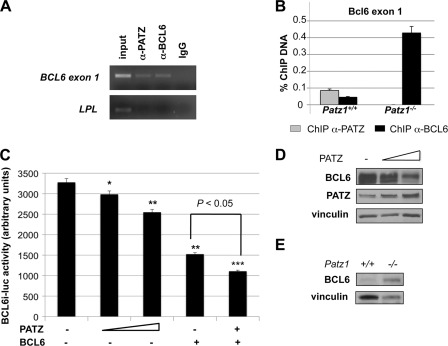FIGURE 2.
Role of PATZ on BCL6 promoter. A, ChIP analysis performed on Raji cells using specific anti-PATZ and anti-BCL6 polyclonal antibodies to detect the endogenous in vivo binding of PATZ and BCL6 to exon 1 of BCL6. The recovered DNA was used as a template for PCR with primers that specifically amplify exon 1 of BCL6 or the promoter region of the LPL gene (negative control). input indicates PCR products with chromosomal DNA without immunoprecipitation. Nonspecific IgG was used as a negative control. B, ChIP assay, revealed by quantitative PCR, on spleens from Patz1+/+ and Patz1−/− mice to detect the binding of PATZ and BCL6 proteins to exon 1 of Bcl6 DNA. The percentage of immunoprecipitated DNA with respect to the input is reported. C, luciferase activity of the BCL6 promoter (−4.9 to +2.0 kb) in Raji cells. Where indicated, 0.25 and 0.5 μg of PATZ and/or 5 μg of BCL6 expression vectors were co-transfected with the BCL6i-luc plasmid. Where required, backbone vectors were also transfected to reach the same total amount of DNA for each experimental point. Data express mean ± S.D. of three independent experiments. Asterisks indicate the statistical results of a multiple comparison test versus promoter basic activity. *, p < 0.05; **, p < 0.01, ***, p < 0.001. D, representative Western blot analysis to detect BCL6 expression in Raji cells transfected or not with increasing amounts of PATZ expression plasmid, as in C. As a control for equal loading, the same blot was incubated with antibodies against vinculin. E, Western blot analysis of BCL6 expression in mouse embryonic fibroblasts from Patz1+/+ and Patz1−/− mice. Vinculin has been analyzed as a loading control.

